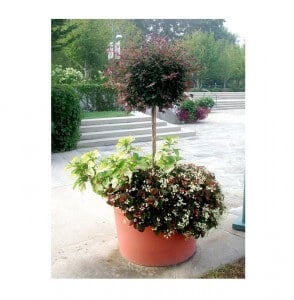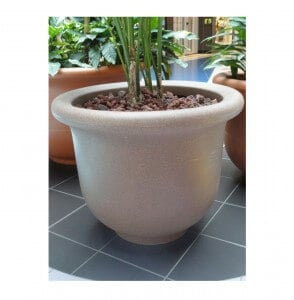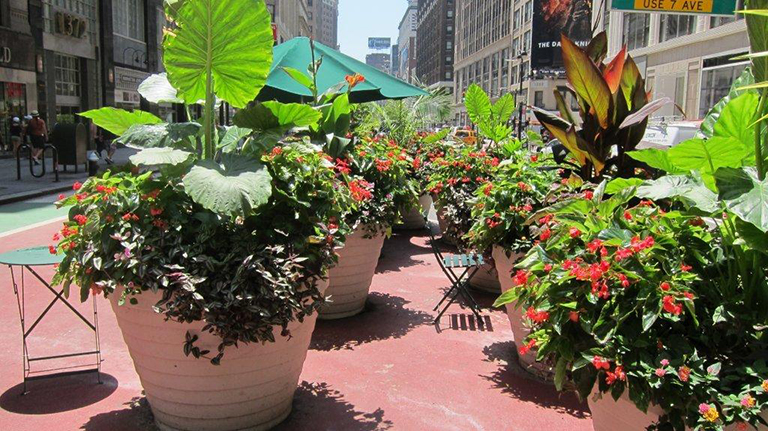Large outdoor planters make a beautiful statement, hence why they are used to decorate businesses, public squares, and private gardens. There are endless options when it comes to large outdoor planters, you can mix and match a variety of beautiful flowers, plant a few bushes, or even grow a full-grown tree.
Large outdoor planters are incredibly popular, and for that reason people tend to have a lot of questions about them. Here we answer some of the most commonly asked questions about large outdoor planters.
 1. Do large outdoor planters come in self-watering variations?
1. Do large outdoor planters come in self-watering variations?
Yes, even the largest outdoor planters can be made as a self-watering planter. Self-watering planters reduce the amount of work you have to do, and increase the chances your flowers flourish—a win-win for all.
2. How do you move large outdoor planters?
A big concern with oversize planters is weight. Moist soil, roots, and plants add up in weight, getting heavier and heavier the more that the plant flourishes. Potted plants can be set on platforms with wheels to make moving easier, another option is to utilize a dolly. Weight will vary, not only depending on the size of the planter but what materials the planter is made out of. You want lightweight large planters that are still very durable.
3. What do you put at the bottom of a large planter?
Large planters can be really large, so large in fact it seems silly to fill the entire thing up with soil. A large planter can consume numerous bags of soil, so before you just start pouring away you should know you are only wasting money and making your planter way heavier.
Adding something to the bottom of a planter is your best bet. Just make sure there is one hole at the bottom of the planter so that water has the chance to escape and will not build up inside creating a moldy environment. Also, make sure you don’t use filler prone to rotting.
Options for filling your large planter include: gritty sand, coconut fiber, milk jugs, foam packing materials, and many more. Your filler should consume at least ¼ of the space in your planter, and no more than 1/3 of the space.
If you are using bulkier fillers, such as plastic jugs, you can secure a filter sheet between the filler and first layer of soil in order to keep the soil from going everywhere. (Read More)
4. Can you plant trees in large planters?
Just because you don’t have an in-ground location to plant a tree doesn’t mean you have to forget about a beautiful tree. Large planters make the perfect home for smaller varieties of trees. Many trees come in dwarf varieties, which grow slower and never as large, offering a great option for potted trees. The important thing is to make sure the roots have adequate room to grow and the tree is given the proper dose of water and sunshine it requires.
5. What are the best materials for large planters?
You want to avoid buying a large planter made of clay or some other material that is going to increase how much it weighs. Once loaded with soil and plants the planter is only going to get heavier. Plastic tends to be a popular choice because it offers a lighter option, but plastic is not going to hold up for long. Our specially made resin planters offer the best lightweight, durable option currently on the market.
 6. What are the best plants for large planters?
6. What are the best plants for large planters?
You have many different options to pick from when it comes to filling your large planter. You can use one large plant, many variations of the same plant or different plants. The options are truly endless, and leave you a lot of room to get creative.
If you are going to mix several types of plants you might be interested in the style design known as “thriller, filler and spiller.” A thriller plant is something that stands out, the filler takes up a lot of the space so you aren’t looking at soil in between flowers, and the spiller comes out over the edges to give a pretty pop-out appeal to the overall planter.
If you do plan to use different plants to fill one planter make sure that all plants require the same amount of water, sunshine and soil type. Otherwise you will struggle to keep all flowers flourishing at the same time.
7. How should I arrange multiple plants in one large planter?
There are two methods used to fill a large planter with a combination of plants. One of which is traditional planting and involves leaving enough room between each plant so that the container appears full within 2 to 3 weeks, but not immediately. The second method is living plant arrangement, which looks full right away.
The general rule of thumb is to use about 3 or 4 plants at the most in one 10-12 inch planter. In a 16 to 20 inch planter you can use around 5 to 8 plants, and so forth from there. The important thing is to give the plants enough space to grow. You don’t want the roots to become tangled up together, which could stump plant growth. (Read More)
8. Where Can You Buy Large Outdoor Planters?
Large outdoor planters are offered for sale at a number of locations, but it’s important to pick wisely. You don’t want to purchase a large outdoor planter only to replace it the following year due to excessive wear and tear. Quality is of utmost importance with large outdoor planters. They need to be able to withstand rain, hot to cold temperature fluctuations, and natural wear and tear.
TerraCast Products offers the highest quality large outdoor planters available on the market. Our state of the art manufacturing process produces planters resistant to rust, corrosion, graffiti and even the most extreme weather conditions.

